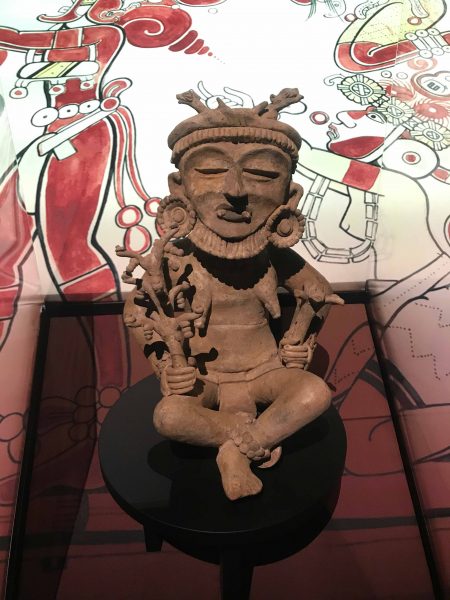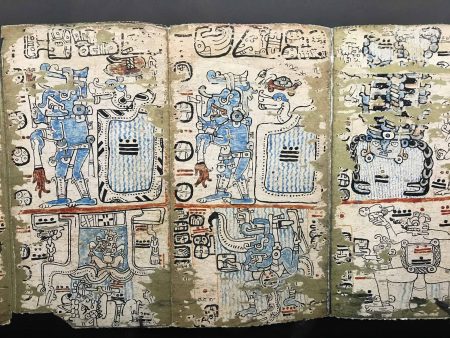Before the pyramid builders in Egypt began their staggering achievements, in our Americas, ancient people were erecting pyramids that rose splendidly and improbably above the formidable rainforests of Central America and Mexico. Like the Egyptians, the ancient Maya civilization had an elaborate pictographic language. Little known too, is the fact that it was the Maya culture that invented the concept of zero that accelerated their genius with mathematics. Our schooling has us look to Europe as the source of civilization, yet civilizations arose on multiple continents, ours among them. The European view is that Columbus ‘discovered’ the wild Americas, but the Americas were already populated by advanced civilizations making arrestingly beautiful art, artifacts, writings and advancing mathematics and astronomy.
All this – hidden in the lush rainforests after their glorious civilization declined and disappeared – only to be re-discovered a thousand years later. 1848 marks the discovery of the ancient city of Tikal within the vast engulfing rain forest, consisting of three thousand buildings, six major temples all lost to time and several thousand more structures that are yet to be unearthed.
Even at the start, the rainforest was a punishing landscape. The soil is thin and thus barely supports crops for the thousands of people who eventually populated ancient Maya. It is important to focus on this tropical setting since it really is the locus of the story of the rise and disappearance of this rarefied culture and the beautiful and otherworldly art and artifacts that survived for us.

The Cincinnati Museum Center exhibit is large and exciting, bringing artifacts largely from Central America to us – unearthing a world of gods and innovators before our eyes. The museum finds the Maya to be “early disrupters, living in cities of stone carved into the rainforest. By studying the stars they developed a calendar more accurate than any other in the world. Their discovery of the number zero opened the door for advanced mathematics. Rubber balls were essential to Maya sports centuries before the “discovery” of vulcanized rubber. And they introduced the world to chocolate. Theirs was a civilization of astronomers, mathematicians, inventors and gods.”
How do we view an ethnographic exhibit such as this? Certainly with an open mind and a realization that our present sense of art and of functional objects will color how we see any of these or any objects within an ethnographic context. So naturally we see the figures of gods and rulers as magical for their raw elegance. The Head of a Ruler pictured above is as impactful as any of the stone portraits of the Egyptian Pharaoh Akhenaten. The approach is for maximum impact with straightforward means, moving the malleable clay with deftness to suggest features and headdress. The portrait of the ruler seems somewhat generic yet his large nose and drooping cheeks may have been significant distinguishing features of this particular royal. He definitely does not have the formulaic look of much of classical Greek portrait sculptures.

Another example of Maya figural art is representations of their gods and goddesses. The Maya had a pantheon of about eight thousand gods. This is almost an unimaginable number and added to it is the fact that Mayans believed gods could shape shift and gender shift. Poor Maya priests! I was taken with an intact terra cotta statue of the Goddess Ixchel that is enchanting. She is the protectress of childbirth and is portrayed in advanced age. Observe her sagging breasts and softly curved, serene closed eyes. She is meditating on behalf of those about to be born. Her countenance is serene, unlike the Head of a Ruler who glares at us.
Maya: The Exhibition features over 300 original objects that detail daily life, religion, politics and innovations of the Maya. The exhibit design features the civilization’s iconic stepped pyramids and the vibrant colors of Maya artwork. Pristinely preserved clay and stucco figurines and elaborate jade and gold jewelry showcase their artistry. Hieroglyphs carved into massive stone slabs demonstrate their sophisticated writing and passion for history. It is possible to follow the writing with a legend that helps you decipher the hieroglyphs.
Large stone carvings and massive stucco sculptures portray some of the large pantheon of Maya deities. The deities are represented in a style quite foreign to us. The are all made of very cartoon-like, interlocking, highly curved forms. I am reminded of early Crazy Katz cartoons as well as the curving forms of the sculpted masks of First Nation peoples of Canada. The Maya use of painting is exquisite, their brushwork deft and bold. These tablets are crazy, fun, and weird, inventive and highly stylized, fascinating and we really don’t know what we are really seeing. Our assessment must be so humble and so fragmented compared with the truth of the matter. Locked in these objects for centuries.
Naturally the exhibits also showcases the tools used to make the art and everyday objects – bowls, storage jars, cocoa cups. (Don’t forget that all-important chocolate! These tools and everyday items reveal the foods, work and play that defined daily life. A really lovely element was a series of videos of present-day Maya people who were videotaped explaining various objects, their importance and symbolism. This was quite riveting and it is worth going to this exhibit just to see these videos of dedicated Maya explaining their cultural objects and history for us. This allows us to get a more intimate understanding of certain objects and to treasure the fact that these people have survived invasions, natural disasters and government abandonment. Yet, they are here to share their knowledge with us.

For those of you with a more historical focus here are some facts from the Cincinnati Museum Center:
“Discoveries of the last 20 years have transformed our understanding of the people and why the great Maya cities were abandoned in the heart of Central America,” says Dave Duszynski, president of Mercury Museum Services, a subsidiary of Cincinnati Museum Center. “Never before has such a spectacular set of Maya artifacts traveled to North America. We are thankful that Guatemala is sharing these amazing national treasures with Cincinnati.”
The Maya flourished in cities of stone carved into the jungles of Mexico, Guatemala, Belize, Honduras and El Salvador. Their civilization dates as far back as 3400 BCE but reached its height in 600 CE, a period when its population density surpassed every other in the world. Their understanding of science, astronomy and mathematics was equal to or greater than other world cultures. They were early disrupters – inventors, innovators and geniuses whose accomplishments continue to shape our daily lives.
By studying the stars they developed a calendar more accurate than any other in the world. “With the Maya we can explore and see how people without any contact to other civilizations in Europe, Africa or Asia came up with similar ideas, inventions and solutions,” say Dr. Nikolai Grube, curator of Maya: The Exhibition and professor of anthropology of the Americas at the University of Bonn.
While the exhibition looks back at the height of the Maya civilization, it also acknowledges the millions today who still speak a Mayan language and the many more who are direct descendants. Far from being a lost or ancient civilization, the Maya thrive today in renewed vibrancy. “The Maya civilization was never lost,” says Dr. Grube. “This was a very romanticized 19th century European perspective on the Maya. What were lost were the big cities in the rainforest. The Maya of today preserve many ideas, languages and forms of living of their ancestors.”
The exhibition also includes a section focusing on the archaeological work the University of Cincinnati is doing at Maya sites in Central America. For over three decades, University of Cincinnati researchers have conducted research, fieldwork and analysis to better understand the Maya and what may have led to the abandonment of their large cities. Their research reveals details about how the Maya managed their land, forest and water resources and how they perceived the world around them. The gallery invites guests to consider how the strategies of Maya innovation and adaptation might apply to parallel challenges we face today.
“Although the culture is ancient, Maya sent a very modern message,” adds Dr. Grube. “They were able to live in a tropical jungle without destroying it and they developed a very sophisticated agricultural system, which included the construction of terraces and a system of canals for collecting, managing and preserving water, even in dry seasons. It’s a valuable lesson of resource preservation for all of us.”
–Cynthia Kukla